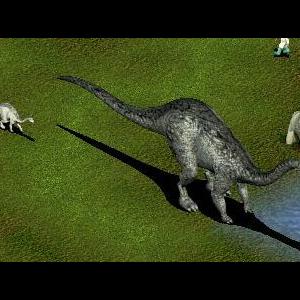About This File
Argentinosaurus (meaning "Argentina lizard") was a herbivorous sauropod dinosaur genus that was quite possibly the largest, heaviest land animal that ever lived. It developed on the island continent of South America during the middle of the Cretaceous Period (around 100 million years ago), after all of its more familiar Laurasian Jurassic kin — like Apatosaurus — had long disappeared.
Not much of Argentinosaurus has been recovered: just some back vertebrae, tibia, fragmentary ribs, and sacrum. One vertebra had a length of 1.3 meters and the tibia was about 155 centimeters (58 inches). However, the spectacular proportions of these bones and comparisons with other sauropod relatives allow paleontologists to estimate the size of the animal. Early reconstructions estimated Argentinosaurus at 35 meters (115 ft) in length and a weight of perhaps 80 to 100 tonnes. More recent estimates based on Saltasaurus, Opisthocoelicaudia and Rapetosaurus suggest sizes around 22-26 meters (72 - 85 ft).[1] It is the largest dinosaur for which there exists good evidence. Although it might have been smaller than Bruhathkayosaurus, which may have reached 44 meters (144 ft) in length and weighed 180 tons (however like Argentinosaurus it has been estimated shorter, at 28-34 meters (92-112 ft)), as well as the poorly known Amphicoelias fragilimus, which may have been up to 60 meters (200 ft) long, these estimates cannot be validated due to lack of evidence.
Vast wings on the vertebrae suited the attachment of massive muscles
The type species of Argentinosaurus, A. huinculensis, was described and published (by the Argentinian palaeontologists José F. Bonaparte and Rodolfo Coria) in 1993. Its more specific time-frame within the Cretaceous is the Albian to Cenomanian epochs, 112.2 to 93.5 million years ago. The fossil discovery site is in the Río Limay Formation in Neuquén Province, Argentina
Argentinosaurus is featured prominently in the permanent exhibition Giants of the Mesozoic at Fernbank Museum of Natural History in Atlanta, Georgia, USA. This display depicts a hypothetical encounter between Argentinosaurus and the carnivorous theropod dinosaur Giganotosaurus. Contemporary fossils of Cretaceous Period plants and animals are included in the exhibition, including two species of pterosaurs, providing a snapshot of a prehistoric ecosystem in what is now the modern Patagonia region of Argentina. At 123 feet (37 m) long, this skeletal reconstruction represents the largest dinosaur mount ever to be assembled.



Recommended Comments
There are no comments to display.
Create an account or sign in to comment
You need to be a member in order to leave a comment
Create an account
Sign up for a new account in our community. It's easy!
Register a new accountSign in
Already have an account? Sign in here.
Sign In Now